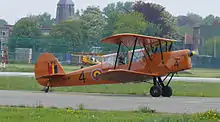Stampe-Vertongen SV.4
The Stampe et Vertongen SV.4 (also known incorrectly as the Stampe SV.4 or just Stampe) is a Belgian two-seat trainer/tourer biplane designed and built by Stampe et Vertongen. The aircraft was also built under licence in France and French Algeria.
| SV.4 | |
|---|---|
 | |
| SV-4C D-EBSH | |
| Role | Two-seat trainer |
| Manufacturer | Stampe et Vertongen |
| Designer | George Ivanov |
| First flight | 1933 |
| Introduction | 1947 (Belgian Air Force) |
| Retired | 1975 |
| Status | Privately owned, or in museums |
| Primary user | French Air Force |
| Number built | 1050 |
History
.jpg.webp)

_in_flight_3.jpg.webp)

The SV.4 was designed as a biplane tourer/training aircraft in the early 1930s, by Stampe et Vertongen in Antwerp. The first model was the SV.4A, an advanced aerobatic trainer, followed by the SV.4B with redesigned wings and the 130 hp/97 kW de Havilland Gipsy Major engine.
Only 35 aircraft were built before the company was closed during the Second World War. After the war the successor company Stampe et Renard built a further 65 aircraft between 1948 and 1955 as trainers for the Belgian Air Force.
A licensed SV.4C version was built in France by SNCAN (Société Nationale de Constructions Aéronautiques du Nord), and in Algeria by Atelier Industriel de l'Aéronautique d'Alger, the two firms completing a combined total of 940 aircraft. The postwar SV.4Cs were widely used by French military units as a primary trainer. Many also served in aero clubs in France, numbers of which were later sold second hand to the United Kingdom and other countries. The Rothmans Aerobatic Team flew SV.4C aircraft from 1970 to 1973.
Variants
- SV.4
- prototype
- SV.4A
- aerobatic trainer with 140 hp/104 kW Renault 4P-O5 engine
- SV.4B
- improved version with 130 hp/97 kW de Havilland Gipsy Major I. Postwar trainers for the BAF were fitted with more powerful Cirrus Major or Gipsy Major X engine
- SV.4C
- licence-built version with 140 hp/104 kW Renault 4Pei engine
- SV.4D
- one aircraft re-engined with 175 hp/130 kW Mathis G.4R engine
A few SV.4s have been fitted with other engines, such as the Lycoming O-320, Ranger 6 or LOM 332b. At least one aircraft fitted with a Lycoming engine (OO-KAT) has been referred to by its owners as an SV.4E.[1]
Military operators
- Royal Air Force
- No. 510 Squadron RAF operated one aircraft "liberated" by Belgian pilots Léon Divoy and Michel Donnet in 1941, and flown from occupied Belgium to England.[2]
Specifications (Post-War SV.4B)
Data from Factory drawings and
General characteristics
- Crew: 2
- Length: 6.8 m (22 ft 4 in)
- Wingspan: 8.385 m (27 ft 6 in)
- Height: 2.775 m (9 ft 1 in)
- Wing area: 18.06 m2 (194.4 sq ft)
- Empty weight: 520 kg (1,146 lb)
- Max takeoff weight: 770 kg (1,698 lb)
- Powerplant: 1 × de Havilland Gipsy Major X 4-cylinder air-cooled inverted in-line piston engine, 108 kW (145 hp)
- Propellers: 2-bladed fixed-pitch propeller
Performance
- Maximum speed: 188 km/h (117 mph, 102 kn)
- Cruise speed: 140 km/h (87 mph, 76 kn)
- Range: 420 km (260 mi, 230 nmi)
- Service ceiling: 6,000 m (20,000 ft)
See also
Aircraft of comparable role, configuration, and era
- Boeing-Stearman Kaydet
- Bücker Bü 131 Jungmann
- Levente II
- de Havilland Tiger Moth
Related lists
References
| Wikimedia Commons has media related to Stampe SV.4. |
- Stampe & Vertongen museum Archived 2007-07-17 at the Wayback Machine
- OO-ATD and the flight to freedom
Further reading
- The Illustrated Encyclopedia of Aircraft (Part Work 1982-1985). Orbis Publishing.
- Pacco, John. "Stampe & Vertongen SV-4B" Belgisch Leger/Armee Belge: Het Militair Vliegwezen/l'Aeronautique Militaire 1930-1940. Aartselaar, Belgium, 2003, pp. 85–86. ISBN 90-801136-6-2.